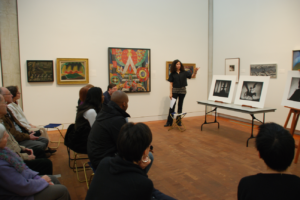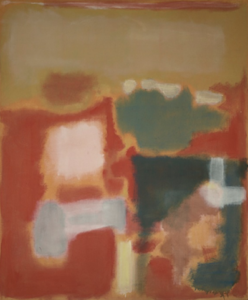
Mathew Brady, American 1822 – 1896, Reverend Stephen Brown with his Invention
quarter-plate daguerreotype, Collection of Michael Mattis and Judith Hochberg
Today’s post comes from Olivia Zisman, class of 2016 and Art Center Student Docent.

Caped Man and Wife, Standing
half-plate daguerreotype
Collection of Michael Mattis and Judith Hochberg
On Friday, April 10th, the Art Center’s current exhibition, Through the Looking Glass: Daguerreotype Masterworks from the Dawn of Photography, opened with a lecture by John Wood, one of the premier historians of early photography, and author of several books on daguerreotypes that are widely recognized as landmark publications.
Invented by Louis Daguerre and shown for the first time to the public in Paris in 1839, the daguerreotype was the first successful method of photography. It was an invention that not only revolutionized the arts, but also had a profound effect on science, technology and social history. The daguerreotype was immensely popular in both France and America; however, it was in America where this new medium had its greatest commercial and social impact. For the first time, photographic representations of everyday life became the forms on which the American people would build their collective cultural identity. Through the Looking Glass is a comprehensive survey exhibition of 140 daguerreotypes featuring important examples from both sides of the Atlantic. All the major collecting genres of daguerreotypes—landscapes, occupationals, post-mortems, erotic stereoviews, and of course, portraits—are represented in the exhibition.
The invention of the daguerreotype had an immense impact on portraiture in the mid 19th century. In liberating the portraiture from the medium of painting, the daguerreotype can be understood as having democratized the genre. No longer was it considered to be the exclusive birthright of the wealthy—the daguerreotype made portraiture affordable for people of all social strata. One widely collected sub-genre of daguerreotype portraiture is the ‘occupational,’ in which a man is depicted with the accouterments of his trade. These occupationals provide a fascinating glimpse into the lives of this entrepreneurial class of

Standing Girl with Large Doll
Sixth-plate daguerreotype
Collection of Michael Mattis and Judith Hochberg
craftsmen and shopkeepers who were being photographed for the first time. In looking at these daguerreotypes—such as the portrait of Reverend Stephen Brown with his wood-grooving machine, ca. 1850—one begins to think about how these people have chosen to be portrayed in their portraits. How do the objects the sitters hold and the poses they strike constitute their identity as represented in the photograph? And how do these choices inform our viewing of them today? In choosing to be immortalized with woodworking machine in hand, Reverend Stephen Brown is making a clear statement about the pride he takes in his craft.
This conscious construction of identity via the photographic medium is something that holds a great deal of weight in today’s culture. Contemporary American society is fixated on the photograph. Our culture has come to revolve around the obsessive documentation and presentation of everyday life, as anyone fitted with an iPhone now has the ability to capture every fleeting quotidian moment. In this context, the democratizing form of the daguerreotype becomes even more pertinent to modern day viewers.
The exhibition will be on view from April 10-June 14, 2015. All works are from the collection of Michael Mattis and Judith Hochberg.




